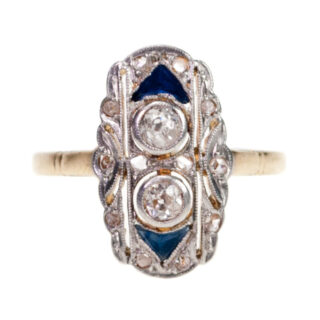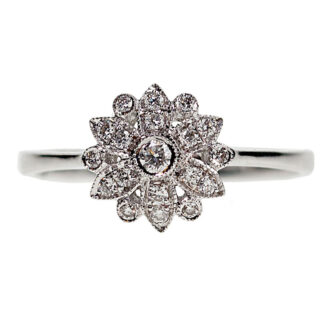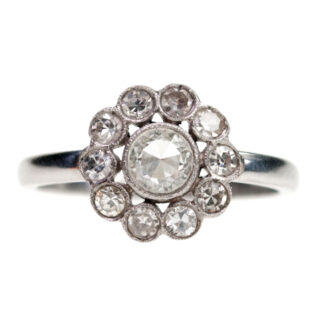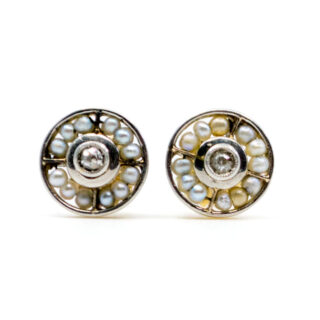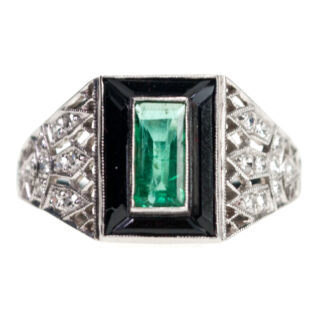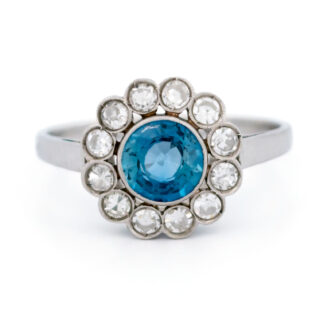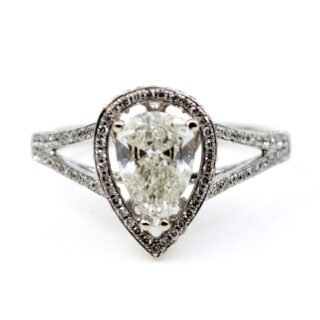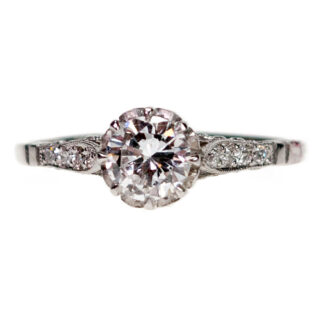This vintage Victorian-design lavalier necklace is a stunning piece of jewelry. Featuring approx. 2.00ct aquamarines accented with pearls, the necklace is beautifully crafted in 9k back and a silver front. The combination of aquamarines and pearls creates a beautiful and delicate design that is sure to turn heads.
Details: ±2.00ct aquamarines, Pearls, 9k, Silver Necklace.
Design Era: Vintage Victorian.
Weight in grams: 8.5.
Condition: Excellent condition – barely used with minimal signs of wear.
Shipping and Pickup: This lovely piece ships from our store located in the center of Amsterdam, The Netherlands. We offer both registered shipping and local pickup at our store. In the case of local pickup, any applicable shipping costs will be refunded.
About Us: Add some sparkle to your style with Binenbaum.com. We offer a stunning selection of antique and vintage jewelry that you won’t find anywhere else. From timeless rings and dazzling necklaces to unique brooches, we have something for every taste and occasion. Visit our website today and treat yourself to a piece of history.
| Design Era | |
|---|---|
| Design & Historical Context | The Victorian Era was a time of great cultural and artistic flourishing in England, and this was reflected in the jewelry of the time. During the Victorian Era, a middle class began to emerge, which sparked a demand for jewelry in the mass market. Jewelry trends during this time often reflected the tone of current events. The Victorian Era is usually divided into three subsections: the Romantic Period (1837-1861), the Grand Period (1861-1880), and the Aesthetic Period (1880-1901). During the Romantic Period, jewelry featured nature-inspired designs similar to those of the Georgian era, and was characterized by its intricate and delicate detailing. Lockets and brooches were popular for daytime wear, while colored gemstones and diamonds were worn in the evening. During the Grand Period, known as the Mid-Victorian era, jewelry was often influenced by the death of Queen Victoria's husband. Many jewelry pieces from this period have solemn, somber designs and feature heavy, dark stones such as jet, onyx, amethyst, and garnet. This period also saw the emergence of highly creative, colorful designs using shells, mosaics, and gemstones. During the Aesthetic Period, jewelers used diamonds and feminine, bright gemstones such as sapphire, peridot, and spinel. Star and crescent designs, as well as elaborate hat pins, were also popular. Some scholars believe that the Aesthetic Period began earlier, in 1875, and ended as early as 1890. |
| Key Materials | |
| Materials & Craftsmanship | aquamarine Aquamarine is a gemstone that belongs to the beryl family and is known for its pale green-blue to medium dark blue color. Its name comes from the Latin word "aqua," which means "water," and "marina," which means "from the sea," reflecting the gemstone's color and association with the ocean. Aquamarine is a hard and durable gemstone, making it suitable for use in all types of jewelry. It is often cut into faceted stones or shaped into cabochons for use in engagement and wedding rings, earrings, pendants, and other types of jewelry. Aquamarine is found in various parts of the world, including Brazil, Madagascar, and Zambia. The color of aquamarine is caused by iron impurities within the crystal, and the deeper the color, the more valuable the gemstone is considered to be. In addition to its beauty and durability, aquamarine is also believed to have certain healing properties and is often used in crystal healing practices. It is said to promote calm and balance, and to have a soothing effect on the mind and body. Aquamarine has been popular for centuries, and it is still a highly sought-after gemstone today. Pearl Pearls are small, round, and lustrous objects that are produced by certain types of mollusks, which are invertebrate animals that belong to the phylum Mollusca. Mollusks include a wide range of species, including oysters, clams, mussels, snails, and octopuses, among others. While all mollusks have the ability to produce pearls, only a few varieties are able to create gem-quality pearls that are suitable for use in jewelry. These include the oysters that produce akoya pearls, the freshwater mussels that produce freshwater pearls, and the South Sea and Tahitian pearls, which are produced by large saltwater oysters. Pearls are formed when an irritant, such as a grain of sand or a parasite, enters the mollusk and becomes trapped inside its shell. In response to the irritant, the mollusk secretes a substance called nacre, which coats the irritant and eventually forms a pearl. The quality of a pearl is determined by a number of factors, including its size, shape, color, and luster. High-quality pearls are prized for their beauty and are used in a variety of different types of jewelry, including necklaces, earrings, and bracelets. 9k 9 karat gold is an alloy made up of 37.5% pure gold and 62.5% other metals, such as copper, silver, or zinc. The addition of other metals allows for the creation of gold in various colors, including yellow, white, and rose. 9 karat gold is a common choice for jewelry as it is less expensive than higher karat gold, due to the lower percentage of pure gold in the alloy. 9 karat gold is also slightly harder and more durable than pure gold, making it more resistant to scratches and dents. Silver Silver is a white metallic element that is known for its excellent conductivity of heat and electricity. It is represented on the periodic table of elements by the symbol Ag, and it is a member of the noble metals, which are known for their excellent resistance to oxidation. Silver is a relatively soft metal, with a hardness that is intermediate between gold and copper. It is more malleable and ductile than gold, which means that it can be easily shaped and molded into various forms. However, it is not as hard as copper, which means that it is more prone to scratches and other types of damage. Because of its softness, silver is usually alloyed with another metal to harden it enough to maintain the desired shape and details when it is used in jewelry and other decorative objects. This helps to give it the necessary strength and durability for use in these types of applications. Throughout history, silver has played a prominent role in the production of jewelry and objets d'art. It is prized for its beauty and versatility, and it is often used in a wide variety of different types of jewelry, including rings, earrings, pendants, and bracelets. It is also used in decorative objects, such as candlesticks, vases, and other decorative items. |
| Gender | |
| Weight (in grams) | 8.5 |
| Condition | Excellent condition – barely used with minimal signs of wear |
Enhance the Beauty of Your Jewelry with Proper Care
Wearing your jewelry is a special way to express yourself and add a touch of personal style to any look. However, to ensure your jewelry remains in pristine condition, there are a few simple steps you need to take to keep it looking its best.
General Care Instructions:
Remove jewelry when showering or bathing, especially when at the beach, in the sea or in chlorinated water.
Avoid wearing jewelry while doing physical work such as housekeeping, gardening or exercise.
Storing your jewelry in a dry and cool place will help protect it from moisture, dirt and dust.
Keeping it away from harsh chemicals such as bleach, ammonia and chlorine will help to avoid discoloration and damage.
Cleaning your jewelry regularly with a soft cloth will help to keep it looking shiny and new.
Avoid exposing your jewelry to extreme temperatures, such as leaving it in direct sunlight or near a heater, as this can cause damage.
Handle your jewelry carefully and avoid dropping it, as this can cause the stones to loosen or the metals to scratch.
Finally, if possible, have your jewelry professionally checked and serviced. This will ensure that any potential problems are spotted and fixed before they become worse.
By following these tips, you can enjoy your precious jewelry for many years to come.
Related products
-
Diamond Sapphire 18k Deco Ring 7331-1947
€ 1.595,00 VAT incl. (where applicable) -
Diamond 18k Cluster Ring 7035-0694
€ 1.395,00 VAT incl. (where applicable) -
Diamond Platinum Cluster Ring 4985-4693
€ 2.695,00 VAT incl. (where applicable) -
Diamond Pearl 18k Cluster Earrings 8277-1998
€ 695,00 VAT incl. (where applicable) -
Diamond Emerald Onyx Platinum Deco Ring 7339-4900
€ 3.895,00 VAT incl. (where applicable) -
Sapphire Diamond Platinum Cluster Ring 7935-4780
€ 3.995,00 VAT incl. (where applicable) -
Diamond 14k Pear-Shape Ring 6995-1894
€ 6.695,00 VAT incl. (where applicable) -
Diamond Platinum Solitaire Ring 7010-1936
€ 5.695,00 VAT incl. (where applicable)
- Home
- Collection
- Fine Jewelry
- Silver Jewelry
- Silverware
- Boxes
- Candlesticks
- Salt and pepper shakers
- Miniatures
- Salt cellars
- Spoon Set
- Condiments
- Frames
- Napkin Ring
- Spoon
- Oddities
- Cups
- Vases
- Cutlery
- Serving Spoon And Cake Server
- Candlesticks
- Baskets
- Hanukkiah
- Spice Tower
- Yad
- Tea Set
- Sugar Castor
- Napkin Rings
- Wine Bottle Coaster
- Wine Stopper
- Tea Pot
- Jugs
- Rattles
- Hip Flask
- Miscellaneous
- Rings 💍
- About
- Contact





